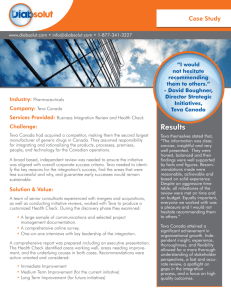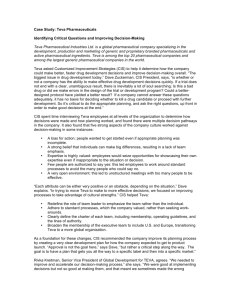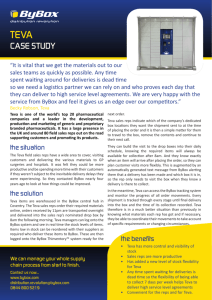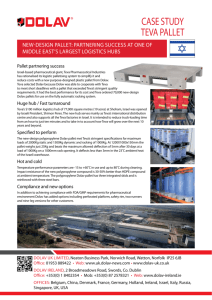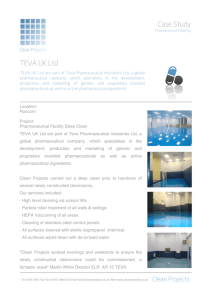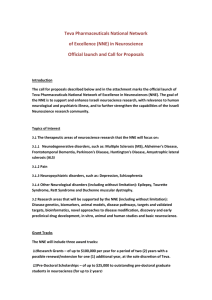EC7006 Case Study - London Metropolitan University
advertisement
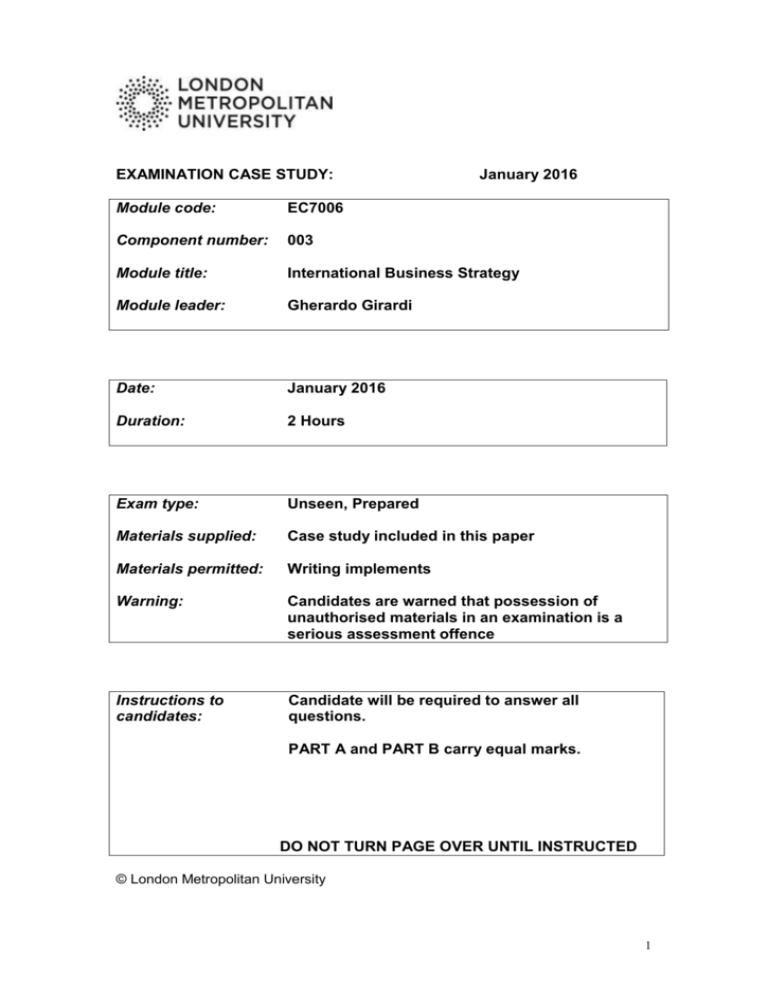
EXAMINATION CASE STUDY: January 2016 Module code: EC7006 Component number: 003 Module title: International Business Strategy Module leader: Gherardo Girardi Date: January 2016 Duration: 2 Hours Exam type: Unseen, Prepared Materials supplied: Case study included in this paper Materials permitted: Writing implements Warning: Candidates are warned that possession of unauthorised materials in an examination is a serious assessment offence Instructions to candidates: Candidate will be required to answer all questions. PART A and PART B carry equal marks. DO NOT TURN PAGE OVER UNTIL INSTRUCTED © London Metropolitan University 1 PART A Why Teva Paid $40.5 Billion for Allergan’s Generic Business Knowledge@ Wharton, Aug 5, 2015 On July 27, Israel’s Teva Pharmaceuticals acquired the global generic pharmaceuticals business of Dublin-headquartered Allergan in a $40.5 billion deal. The first obstacle to understanding the importance of this deal is the slew of superlatives around it. Even before this latest acquisition, Teva was flaunted as “the biggest company in Israel.” This is technically accurate, although it has long been a multinational with production facilities around the world. Also, most of its shares are owned by non-Israelis and traded in the U.S. The deal itself has been hailed as “the biggest M&A deal in Israeli history,” and its announcement led to Teva’s shares making their biggest-ever jump (16%) and reaching their highest-ever price ($72), giving the company its highest-ever valuation ($61 billion). All of this is objectively true. But these bits of information, including a description by one media commentator — “the most dramatic deal in the history of Israeli business” — are of limited use in assessing the deal’s importance or potential results. The drama being referred to was the abrupt switch made by Teva from pursuing and then ditching Mylan NV, a Dutch rival which had fiercely resisted its approaches, in favor of Allergan. Given the amount of money on the table — both deals were priced in excess of $40 billion — and the exceptionally rancorous and highly publicized exchanges between the bosses of Mylan and Teva, there was indeed plenty of passion and much at stake. But perhaps the best place to start is not at the end, with the rapid consummation of a friendly deal between Teva and Allergan, nor in the middle, when Mylan spurned a similarly priced offer from Teva. The first question that needs to be answered is why Teva wanted to make a mega acquisition at all. Caught in the Deal Wheel One answer is that the entire pharma industry is caught up in a whirlwind of enormous deals. Data from Thomson Reuters shows that as of July 23 — prior to Teva’s Allergan acquisition — M&A deals in the health care industry so far this year totaled almost $400 billion and were up some 80% over the equivalent period of 2014. Thus Teva, like every other firm in its sector, faced only two choices: Buy or be bought. Sitting quietly on the sidelines was not a realistic option. According to Elah Alkalay, vice president for business development at IBI Investment House, a leading Israeli investment firm, the rationale behind this intensive bout of M&As — other than the easy availability of cheap financing to facilitate mega deals — includes three features of the pharma business 2 which collectively exert strong pressure on the boards and executives of pharma firms. “First, in the generic drugs business — in which firms launch cheap generic versions of formerly exclusive drugs whose patents have expired — everslimmer margins have been driving a decade long consolidation process,” Alkalay says. “The industry is now entirely commoditized [and forcing] companies to achieve greater economies of scale. [This is possible] by buying or merging with competitors. “Second, the number of ‘ethical’ or proprietary drugs coming off patents in the next few years is going to be much smaller than has been the case over the past decade or so,” she continues. “Finally, the drug producers are facing a rapid process of concentration among their main buyers — especially in the critical U.S. market, where there are now three dominant companies. This, in turn, is forcing the manufacturers to consolidate their ranks, so as to better match the greater bargaining clout of their customers.” Erez Vigodman, Teva’s CEO since early 2014, is well aware of these trends. He spent his first year in a concentrated effort to squeeze costs and improve Teva’s operating efficiencies, and announced that 2015 would be a year of strategic development. That could only mean one thing: Teva would make a major purchase – and one that chimed with the strategy chalked out by Vigodman’s controversial predecessor, Jeremy Levin. The latter had lost the confidence of the board and been forced to quit, but his strategic vision had been agreed upon and accepted. According to Steven Tepper, pharma and biomed analyst at Migdal Capital Markets and regarded as a top Israeli analyst in this sector, Vigodman has been the executor of the Levin strategy. Tepper considers Vigodman “a genius” for his adroit handling of the negotiations, first with Mylan and then Allergan. But part of Vigodman’s success, he says, is that he accepted the validity of his predecessor’s game plan and made it his own. Sponsored Content: “Levin was instrumental in bringing Michael Hayden to Teva as head of R&D, and together they formulated a corporate strategy for Teva that distinguished it from its competitors and also explains why Teva had to acquire either Mylan or Allergan,” says Tepper. He adds that within the wider pharma sector, there are “ethical” companies that develop proprietary drugs, and there are generic companies. Teva had formerly been a generic company, but the unexpected success of its Copaxone drug for treating multiple sclerosis made it a hybrid. However, the enormous profits generated by Copaxone are now set to fade as its patent’s expiration opens the way for generic versions. This has been the strategic threat facing Teva in recent years. Says Tepper: “Levin and Hayden sought to marry Teva’s proven capabilities in the efficient production of generic drugs with the company’s in-house R&D capabilities, themselves enhanced by a series of acquisitions. The goal is to 3 turn generic drugs into specialty products, for instance by giving them a special formulation or method of application — something that doesn’t change the essence of the drug, but de-commoditizes it and allows for a higher price, higher margins and hence greater profitability.” Hayden stayed at Teva after Levin left — something Tepper regards as critical for the company’s future, and which enabled Vigodman to adhere to the Levin-Hayden strategy of making Teva both a generic giant and a creator of original drugs. However, for this to work in the face of the competitive pressures of the industry, Teva had to make a major acquisition. After 15 months of focusing on streamlining the company, Vigodman was ready to make a strategic move. Finding the Right Fit Of the three potential acquisition candidates, Sandoz, a leading generics company owned by global pharma giant Novartis, is known to be “not for sale.” That left only Allergan and Mylan. Both of these, like Teva itself, had been created or reshaped by a series of mergers and acquisitions stretching back years and even decades. However, Allergan had only just emerged from a merger between Actavis, a generic company, and Watson Pharmaceuticals, and did not seem ready to turn around and demerge — which is what a Teva purchase of Actavis would require. That process of elimination left Mylan, a company now registered in Holland and with its operational headquarters in the U.K., although it grew from a U.S. base. Thanks to a string of acquisitions that included the generics arms of Merck in 2007 and of Abbott Labs in 2014, Mylan — under the dynamic leadership of its CEO, Robert Coury — became one of the world’s leading generics and specialty pharmaceuticals companies. The obvious similarities to Teva and a potential complementarity made a merger between them seem desirable and almost obvious — at least to Vigodman. On April 21, Vigodman made an $82-per-share, half-cash half-equity, $40 billion bid for Mylan. But he had a double challenge. Two weeks prior to Teva’s bid for it, Mylan itself had made a $29 billion bid (later increased to $32 billion) for Perrigo, a pharma firm registered in Ireland. Coury’s attempt to buy Perrigo may have been a strategically defensive or pre-emptive move, designed to make Mylan too big for Teva — or anyone else — to swallow. Mylan’s bid for Perrigo not only forced Teva into making an immediate bid for Mylan, but Vigodman also had to persuade Mylan’s shareholders that buying Perrigo was a bad idea while being bought by Teva was a good one. However, both Mylan’s bid for Perrigo and Teva’s bid for Mylan were rejected by the boards of the intended acquirees. Things became messier almost by the day, as Mylan activated a “poison pill” defence against Teva. While this was legal under Dutch law, Teva and its supporters claimed that it was not in the best interests of Mylan’s shareholders. To make matters worse, Vigodman and Coury engaged in an unsavory bout of mutual mudslinging. The entire process could have degenerated into a nasty, lengthy and very expensive legal battle, had a “white knight” not emerged, totally unexpectedly. 4 This was Brent Saunders, CEO of Allergan — the pharmaceutical giant that had emerged from a rapid-fire series of mergers. In November 2012, a generic firm called Watson Pharmaceuticals bought Actavis for €4.25 billion and itself assumed that name. In October 2013, Actavis bought an Irish company, thereby changing its domicile to the low-tax Emerald Isle and, in November 2014, Actavis bought Allergan, the manufacturer of Botox and other drugs, for $70 billion, pushing its market cap to almost $150 billion — and again changed its name. Saunders had masterminded this whirlwind of deals. When he invited Vigodman for lunch in early July — according to the post-deal background stories, at least — he was pursuing his own agenda. Remarkably, the deal that emerged from this meeting and that was wrapped up and announced within a few weeks, provided a genuine win-win for both sides, leaving Mylan as the potential loser — if all goes according to plan. Win-Win The essence of the deal is simple: Teva will buy Actavis, which is the generic arm of Allergan, so that Allergan exits generic pharma and Teva becomes a bigger and more powerful player in that sector, cementing its position as global leader. Allergan wants to focus on developing its own new drugs and will use the proceeds of the deal to pay down some of the debt it has accumulated during its very rapid expansion. In other words, the deal enables both companies to better pursue their own strategies. Everyone agrees that Teva is paying a very high valuation for Actavis, but the rationale for this is that Actavis is actually worth more to Teva than to anyone else. “Teva was probably the best-placed company in the world to buy [Allergan’s generic business],” says Tepper. “The high purchase price is justified by the potentially huge savings it can make through the merger.” Tepper estimates that the savings could be around $1.3 billion to $1.5 billion per annum. This is in line with Teva’s own estimate of $1.4 billion per annum. “Furthermore, most of the $40.5 billion deal is being paid in cash, with only $6.75 billion in shares — just over 10% of Teva’s new market cap and hence a dilution of relatively small scale. Even with the planned issuance of new shares to the same value, as part of the financing of the cash part of the deal, existing shareholders are being diluted by not more than 20% — compared with a dilution level approaching 50% in the Mylan bid,” adds Tepper. But much more important for Teva’s long-term development is the neat fit between it and Actavis. Tepper and other analysts believe that there will be far fewer anti-trust issues to sort out with the regulators from the U.S. Food and Drug Administration in the Actavis deal, because there is less overlap between Teva’s existing portfolio of generic drugs and that of Actavis than there would have been had the Mylan deal gone through. These cost savings will help Teva boost its free cash flow to $6.5 billion next year and even more in subsequent years. This will enable it to both rapidly 5 reduce its debt load and also to finance more R&D aimed at developing specialty products and ensuring that it remains a hybrid firm. But it’s not all just about numbers. Behind the numbers are key players who can exert disproportionate influence on the outcome of these mega deals. In the case of Teva, Tepper highlights two such people. One is Hayden, who as head of R&D, will continue to be critical to the effort to generate new drugs. The other is Sigurdur (Siggi) Olafsson, who prior to joining Teva as head of its generic medicines division in 2014, spent nine years in increasingly senior positions at Watson and its later incarnation, Actavis, ending up as corporate president from 2012 to 2014. “Olaffson was directly responsible for much of the cost savings made by Teva over the last year and more. Before that, he led the same process in making Watson into Actavis. He knows what’s what as well as who’s who throughout the Actavis organization — so if anyone can achieve the projected cost savings and efficiency steps that the success of this deal is predicated on, he’s the man,” says Tepper. Alkalay also notes the critical role of a few senior managers and the implicit risk that poses. But, she says, Teva’s successful record of managing large mergers bodes well for this one. In terms of Teva’s size relative to the Israeli equity market and the country’s business sector, she agrees that “it seems rather a stretch” to still call Teva an Israeli company, given its global reach, its multinational senior management and the fact that its board operates like any major American corporation. However, she adds: “As against that, Teva’s corporate headquarters are still in Israel and, because of its size and prolonged success, Teva has had, and continues to have, enormous influence on the entire Israeli industrial sector. Thousands of managers in various areas have passed through it over the years, have been exposed to an internationally oriented corporate culture that few other Israeli companies can offer, and have taken that with them as they pursue their careers throughout the Israeli economy. That’s something that you can’t quantify, that doesn’t feature in corporate reports — but is nevertheless a major asset to the firm and to the country.” 6
